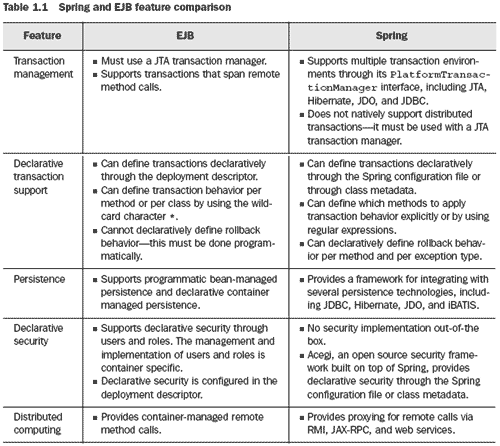Spring in Action: A Spring Jump Start. Part 3
Spring in Action: A Spring Jump Start. Part 3
Written by Craig Walls and Ryan Breidenbach and reproduced from "Spring in Action" by permission of Manning Publications Co. ISBN 1932394354, copyright 2005. All rights reserved. See https://www.manning.com for more information.
1.6 Spring alternatives
Whew! After that whirlwind introduction of Spring, you have a pretty good idea of what it can do. Now you are probably chomping at the bit to get down into the details so you can see how you can use Spring for your projects. But before we do that, we need to cover what else is out there in the world of J2EE frameworks.
1.6.1 Comparing Spring to EJB
Because Spring comes with rich support for enterprise-level services, it is positioned as a viable alternative to EJB. But EJB, as opposed to Spring, is a wellestablished platform. Therefore, the decision to choose one over the other is not one to be taken lightly. Also, you do not necessarily have to choose only Spring or EJB. Spring can be used to support existing EJBs as well, a topic that will be discussed in detail in chapter 7. With that in mind, it is important to know what these two have in common, what sets them apart, and the implications of choosing either.
EJB is a standard
Before we delve into the technical comparisons between Spring and EJB, there is an important distinction that we need to make. EJB is a specification defined by the JCP. Being a standard has some significant implications:
|
Spring and EJB common ground
As J2EE containers, both Spring and EJB offer the developer powerful features for developing applications. Table 1.1 lists the major features of both frameworks and how the implementations compare.

For most J2EE projects, the technology requirements will be met by either Spring or EJB. There are exceptionsyour application may need to be able to support remote transaction calls. If that is the case, EJB may seem like the the way to go. Even then, Spring integrates with a Java Transaction API (JTA) transaction providers, so even this scenario is cut-and-dried. But if you are looking for a J2EE framework that provides declarative transaction management and a flexible persistence engine, Spring is a great choice. It lets you choose the features you want without the added complexities of EJB.
The complexities of EJB
So what are the complexities of EJB? Why is there such a shift toward lightweight containers? Here are a few of the complexities of EJB that turn off many developers:
Writing an EJB is overly complicated - To write an EJB, you have to touch at least four files: the business interface, the home interface, the bean implementation, and the deployment descriptor. Other classes are likely to be involved as well, such as utility classes and value objects. That's quite a proliferation of files when all you are looking for is to add some container services to your implementation class. Conversely, Spring lets you define your implementation as a POJO and wire in any additional services needs through injection or AOP.
EJB is invasive - This goes hand in hand with the previous point. In order to use the services provided by the EJB container, you must use the
javax.ejbinterfaces. This binds your component code to the EJB technology, making it difficult (if not possible) to use the component outside of an EJB container. With Spring, components are typically not required to implement, extend, or use any Spring-specific classes or interfaces, making it possible to reuse the components anywhere, even in the absence of Spring.Entity EJBs fall short - Entity EJBs are not as flexible or feature-rich as other ORM tools. Spring recognizes there are some great ORM tools out there, such as Hibernate and JDO, and provides a rich framework for integrating them into your application. And since an entity bean could represent a remote object, the Value Object pattern was introduced to pass data to and from the EJB tier in a course-grained object. But value objects lead to code duplication¡ªyou write each persistent property twice: once in the entity bean and once in your value object. Using Spring together with Hibernate or another ORM framework, your application's entity objects are not directly coupled with their persistence mechanism. This makes them light enough to be passed across application tiers.
Again, in most J2EE applications, the features provided by EJB may not be worth the compromises you will have to make. Spring provides nearly all of the services provided by an EJB container while allowing you to develop much simpler code. In other words, for a great number of J2EE applications, Spring makes sense. And now that you know the differences between Spring and EJB, you should have a good idea which framework fits your needs best.
Created: March 27, 2003
Revised: March 23, 2005
URL: https://webreference.com/programing/spring/3


 Find a programming school near you
Find a programming school near you